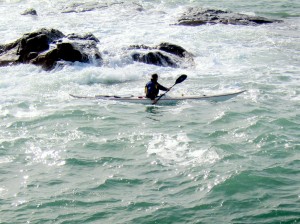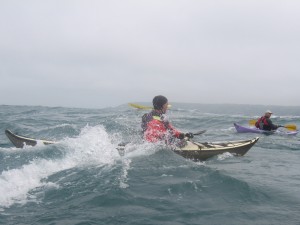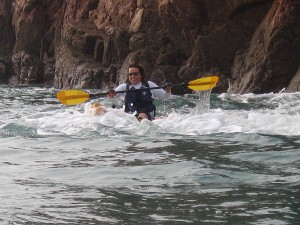“British style sea kayaks are as obsolete as the Model T Ford”…Really?
Greg Barton makes a few criticisms of British sea kayak designs in the American edition of Canoe & kayak Magazine.
“Most recreational paddlers don’t realize that British-style sea kayaks, which lack a rudder and perform poorly in waves, are as obsolete as the Model T. The Brits have done a good job of promoting their way of paddling. But as Oscar (co-founder of Epic Kayaks) says: ‘ They need 5-Star classes so they can teach people how to paddle poorly designed boats’.”
“I view a boat design from a competitive standpoint if you make something that will perform better it will catch on. The problem is that in racing, it’s obvious over time which features are better. But in sea kayaking there’s no objective measure. If someone paddles around New Zealand they think “Okay, the boat made it”, without realizing that a more efficient boat could have made it faster and less effort”.
The article is not online but you can buy the July 2011 digital copy of the Canoe & Kayak magazine.
Greg Barton is a US surf ski champion 2003 & 2004, 1988 Gold 10000m K1 and President of Epic kayaks whose designs have been used in many major crossings and races.
Looking at some sea kayak designs I am not sure where he gets this idea from as I see many high performance British sea kayak designs about. I also see some that are less good.
How do we measure sea kayak performance?
What his remarks do raise is the question: How we decide a sea kayak is a good design?
For me, a lot depends on what you plan to use it for. Just because everyone else is buying model X and it’s featured in all the magazine trip reports and articles does not make it the design that you should buy. Don’t forget there is sometimes a bit of “product placement” going on.
Best sea kayak
I know a few friends use surf ski style craft he describes. Their goal is to cover big distances at sea and offshore rapidly and efficiently.

Your critera for a sea kayak design if paddling a rocky shoreline may be different to an offshore trip
For example the recent 85mile plus paddle around the Channel islands in 19 hours called for a fast approach if they were to catch the tides. In which case this sort of craft is a good design.
I’m not sure how important some of Greg’s criteria is for many paddlers though. Speed and the ability to run large swells is not the only factor. If I want to explore the coastline rather than blast along I’ll probably have at a different set of criteria. If I reckon I’ll be bashing about in some rocks then my light weight composite kayak is going to be staying in the garage.
The great thing about the new wave of surf skis and performance sea kayaks is that the design and construction methods are impacting upon other areas of sea kayaking.
Pushing the limits of sea kayaking
Innovations in motor racing and performance cars eventually influence production cars. Likewise, the demands for rudder systems to withstand race and expedition conditions is leading to improvements in design and robustness. I’m very happy with my light and strong Werner Ikeos paddles -which I suspect owe their construction and design to developments in high performance paddling.
We need people out there pushing designs and their limits. Without this designs stagnate and we will see less innovation with the risk of more and more bland designs that are designed to sell in vast quantities.
Greg’s comments do highlight the importance of considering just what is your criteria when deciding on a good sea kayak design.
I’d also add it’s important to know how to get the most from your choice of kayak.
Derek


